| Egypt to Auckland,
28,000 Km (prologue – f) It was with mixed emotion that I left the
States yesterday. Inhaling I was filled with anticipation
and excitement knowing that I’d be on the road
again. Exhaling came as a sigh, thinking about leaving
friends and family behind again as we set forth on the
next leg of our journey.
Most difficult for me was
leaving my sister and family behind. This year we had a
tumultuous holiday season. Just as my sister was putting
the final arrangements together for her Chanukah party
the world turned upside down for her. Coming home from my
niece’s championship soccer game she felt ill, went
to bed and slipped into a diabetic coma for most of the
next month. Her doctors were extremely pessimistic about
her chances of survival and I sank into a depression so
deep I thought I’d never find my way out.
My sister’s will to
live, her personal strength and her supportive nurses
prevailed. I remember one Saturday morning with her
laying in bed attached to more tubes and wire than you
can imagine. That day I was feeling especially
frustrated. I leaned toward her, called her name loudly
and she opened her eyes turned her head and focused on
me. A week later she responded more definitively. She
opened her eyes and I began to tell her about my day. I
was intentionally vague about a few details and she
arched her eyebrows as if to ask me to clarify at the
right time her voice rendered silent by the breathing
tubes. I gave her a clue visually and she laughed at the
joke that I made that depended on a memory of an
experience three years before. I knew at that moment that
my sister was on the mend.
Passing through LA on our
way out of town it was so satisfying to see the progress
she’d made since then. I was simultaneously thrilled
that she is doing so well and feeling cheated that
I’d constructed this trip and would have to leave
her before I’d see her back in her house with her
daughter.
* * *
An In and Out Burger was
the one thing we couldn’t pass up on our way to the
airport to catch our flight. Its greasy cheesy goodness
filled our tummies and colored our breath with its fresh
onions. We topped off this balanced meal with See’s
candies that my mom had handed me as we left Orange
County. When I left Andy at the curbside at LAX he was so
overcome by his caloric intake that he left his
sunglasses in the car. Upon my return he was overwrought
about their loss. Budget Rent-a-Car came through, finding
them and delivering them to the curb of our terminal. The
happy bus driver was rewarded with a chocolatey reward.
The See’s came in
handy once again when we used them to bribe the ticket
agent to get us good seats on the flight. Our good
fortune there combined with Andy’s famous in-flight
cocktail put him out soundly on the flight. Andy swears
by one vicadin, one halcyon and a glass of scotch for
airplane-bound bliss.
I slept soundly as well,
non-chemically induced, my head buried under my blanket.
I woke as usual two hours before we arrived at 3:30 AM as
my head spun with the possibilities that our new journey
would bring to us. We touched down before dawn our heads
fuzzy from our long transit
|
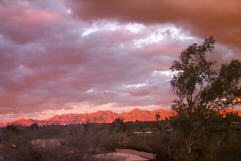 Sunset
over Arizona
|
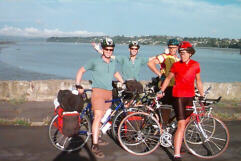 Gary
and Caroline, our first cycle encounter down under
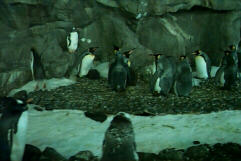
Texan penguins dress for dinner
|
Auckland Airport to
Auckland, 36Km (f) We sat waiting for our bicycles for nearly
an hour not knowing where the heck they were. Standing
nervously by the door marked clearly "Oversized
Baggage" I paced back and forth while we made
friends with a 60ish woman who’d flown from England.
Finally they announced that the Bikes were actually at
the other end of the claim area. Andy and I skipped
(literally) over to them and headed for customs.
I was a little worried
about passing through. The customs form was complicated.
It pandered to the Kiwis’ warranted paranoia over
biological contamination. Because we had bikes, the form
stated that we had to go to agricultural inspection. The
female officer who directed us to the red line questioned
us about our origins, our occupations and purposes. She
had the nerve to ask us if we had pornographic material
on our website. Andy asked her if she’d be the type
that would visit it if it did and fortunately she
didn’t take any offense. Luckily the agricultural
dudes were as easy going as our porn lover friend and
passed us through.
Within a few moments we
were outside the terminal in the humid pre-dawn air
putting Siegfried and Roy back together again.
Constructing a little changing room out of the discarded
boxes we were in lycra and on the road within an hour.
Shockingly this ride proved false the BikeBrats truism
"The road to and from the Airport is always a
drag". Within five minutes we were on a quite road
through farmland, mooing at cows and pumping along
ecstatically.
We saw two cyclists
advancing on us after a few km’s and soon they
caught up with us. Gary and Caroline were out for a
training ride on fast and light racing bikes. They slowed
and guided us into town along nearly deserted roads by
the waterfront. They led us to a vista that gave us a
360-degree glimpse of Auckland. The two parted company
with us just before we mounted the summit, saying it was
too steep for them that their gears were too high for it.
We probably should have turned around right then, put our
tails between our legs and headed to town for brunch. A
few moments later we were dripping with sweat, hearts
leaping out of our chests and our legs screaming at us
for attempting this on our first day out.
The view was worth it. And
the tree on top of aptly named "One Tree Hill"
was certainly magnificent despite its circumcision scar.
A few years ago an angry Maori had tried to cut it down
and had somehow been stopped and the tree saved. A
tourist visiting from Wellington took one look at all the
gear we were carrying and said "got your chainsaw in
there or what?, demonstrating his quick Kiwi wit.
We navigated our way into
sunny, warm and humid Auckland where Andy put his
"brunch curb feelers" on, quickly locating a
hip sidewalk café where we munched and slurped our
second breakfast. This time we were awake enough to enjoy
it. We were disappointed to find that our hotel, the
Albion, didn’t have our rooms ready as promised and
we were just too rank to tour the city without a little
shower. The tourist information office was glad to help
us find an alternative and cancel our little arrangement
with the Albion.
"Power-tourists"
I declared us as we high-tailed it to the waterfront to
board a harbor tour. We anticipated the pinnacle of the
tour to be a stop at the aquarium. This one was hailed as
not your average goldfish tank. It was a reclaimed sewage
treatment plant that now housed live penguins and a shark
tank you can walk through. The penguins were truly cool
but you had to get on this silly tram to see them. The
cars were constructed to simulate snow cats and we had to
bear really cheesy visual and sound effects before
actually viewing the very cool birds. Turns out that 18
of them were shipped in from San Antonio, Texas’ Sea
World. We smiled at their antics as they tobogganed
across their icy enclosure and wowed us with their
underwater grace. The last little scene on our snow cat
ride was a food chain demonstration. There we saw a fake
seal eat a fake penguin and then, in turn, be munched by
an orca (killer whale) that looked more like a blow-up
souvenir from the penguins’ origin than a sea
mammal.
All of this consumption
made me hungry again so we, appropriately, decided on a
seafood snack. Targeting a little lower on the food chain
we opted for a plate of tasty New Zealand green-lipped
muscles sautéed in butter and wine. We mopped up the
juice with soft bread and shared a local beer that was
just a little too malty for my taste. Motoring through
the harbor back towards our hotel we mused about the
coming days and planned our itinerary, wondering what a
night out on the town in Auckland will show us this
night.
|
| 15 February, Auckland
to Kaiaua, 88km (a) After only one full day’s riding in
this country, I am already a convert to the popularly
held belief that New Zealand is a cyclist’s
paradise.
This morning we thought
we’d train out to the end of the suburban line, as
recommended in our guidebook. But a consultation of the
train schedule and a couple of phone calls revealed that
no trains run on Sunday. We’d have to pedal our
butts all the way out of this hilly, sprawling town. Not
exactly cycling bliss, but it was tolerable. The drivers
were the worst part, of course. One trait they all seemed
to share was a tendency to pull into the shoulder in
front of us and fling their doors open. With heightened
awareness, we picked our way along the Great South Road,
which winds through industrial parks, cow pastures and
the rundown centers of suburban towns with names like
Otahuhu and Papatoetoe.
After about thirty
kilometers on the misnamed Great South Road, we turned
off towards Clevedon, where we stopped at a supermarket
"takeaway" for a kind of lunch. Kiwis
apparently like their food deep-fried beyond recognition,
as this was all that was available. The town –like
all the others we had passed through—looked straight
out of the ‘30’s or ‘40’s. Completing
this illusion was a string of old-time roadsters passing
by, presumably on a rally. From here the road became
hillier and treacherously narrow. Apart from the
occasional tree resembling something drawn by Dr. Seuss,
the countryside bore an astonishing resemblance to
Northern California, full of brown hills crested with
pine.
In Kawakawa Bay, we rode
along a beach filled with Maoris affecting a Hell’s
Angels look: beards, bandanas, dark glasses, beer guts
and lots and lots of tattoos. A little further we stopped
at a busy general store, where I observed once again the
Kiwi custom of barefootedness. The place was full of
people shopping, but Fred and I were the only ones
wearing any kind of footwear. I had noticed in Auckland,
too, a surprising number of barefoot people walking in
the street. And at Penguinland yesterday, I saw a placard
explaining how to board and exit the conveyor belt
without shoes.
A signpost informed us
that 31 kilometers lay between our exhausted, jetlagged
butts and our intended destination. And it pointed
straight into a seemingly impenetrable wall of mountains.
Wearily, we climbed back into our saddles for the long
pump up. The scenery more than made up for what was
easily the toughest climb of the day. The road
–suddenly bereft of cars—twisted its way up a
lush, jungle-y gorge, full of the sounds of raucous,
unfamiliar birds and the buzzing and crackling of giant
cicadas. Huge treelike ferns brought to mind images of
happily munching brontosauri. A couple of ups and downs
later brought us into more open countryside: rugged brown
hills full of grazing sheep and dappled with groves of
trees. Following a babbling brook and under a dramatic
sky, it was intensely beautiful, like a dream or a
hallucination. I felt exhausted but happy, lucky to find
myself in such enchanting surroundings.
Eventually our road
deposited us on the coast again, this time beside the
Firth of Thames, across from the towering hills of the
Coromandel Peninsula. We followed its narrow and buckled
course in a blissful yet physically drained state all the
way into Kaiaua. Our only choice for accommodation in
this tiny town was behind the village bar and social
center. After some necessary ablutions, we went inside
and met a whole host of friendly Kiwis. The main hall of
the place was packed with rowdy old folks drinking and
dancing to a hilarious live band. A woman at the bar
explained that we were witnessing a private affair for
the local "Golden Oldies Club." She said that
their chief raison d’etre was taking group
trips abroad. She also told us about "Handle
Club," a weekly raffle for customers who kept their
"handles" (kiwi barspeak for mugs) hung up on
hooks on a big board behind the bar. Bill, the friendly
red-haired proprietor of the place (the Bayview Hotel, if
you’re ever in the neighborhood), showed us photos
of other events hosted there, like the annual hunt for
wild pigs in the forest and a boating competition on the
bay.
It became increasingly
difficult to tear ourselves away from the bar; a spirited
argument erupted between several of the patrons as to
which route would be the best for us to follow south.
Just after bidding farewell to all our new friends, a
toothless and obviously inebriated fellow chimed in that
he wanted to buy us a round. Pleading jetlag, we beat a
hasty retreat back to our room –a narrow escape.
|
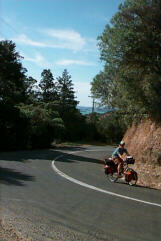 Glories
of being on the road again
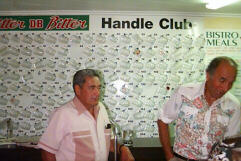
Sunday night in Kaiaua
|
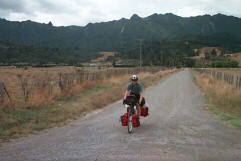 On
the road to Matamata

Bovine "U"
|
16 February, Kaiaua to
Okauia Hot Springs, 111km (f) As we prepared for bed last night, Andy
began to poke fun at me for having set up my mosquito
net. He said it looked like the little tents we had to
put over our food at Basata in Egypt to keep the flies
from dragging off our meals. The tables turned at
midnight when he was scurrying around looking for his. He
had an immense amount if difficulty setting it up. You
would have thought it was a ten thousand-piece jigsaw
puzzle. I finally gave in and helped him just so I could
get back to sleep.
Speaking of sleep, it had
been a long time since I’d slept so well. Once Andy
got settled I didn’t open my eyes once. Then next
morning we arose with the sun (praise the lord that it
doesn’t really rise until around seven). We loaded
our (seemingly extremely) heavy bikes. Mine seems to have
increased in weight during our break. I can only surmise
that the recharge of essentials like sun screen, energy
bars and the like are the culprits. Not ready to admit
that I am not in as good shape as I was when we stopped
riding last year. That is the logical assumption given
how sore my thighs were and tender my taint was this
morning.
With quiet flat coastal
plains nestled up against brown grassed hills on our
right and a marshy-muddy tidal beach we began our day.
Huge black and threatening clouds seemed to close in from
every direction. Luckily they blocked out the punishing
heat of the sun. We stopped to breakfast where we’d
intended to stay the night before at a massive campground
and hot spring. Breakfast was less than inspired, a
couple of "steak" pies and the local Gatorade
equivalent filled our bellies and wet our whistles while
we watched a septuagenarian breast stroke inch-by-inch
across the pool.
The proprietor like every
kiwi had a strong opinion about what route we should take
to make Te Aroha. The big problem is that it is hard to
obtain any kind of consensus of advice here in New
Zealand, which makes it harder to follow advice than to
plan our own path. Turned out to be a mistake to follow
the camping woman’s directions. It led us on icky,
boring, flat roads against the wind and through
construction zones.
The last stretch to Te
Aroha was along a winding rural road without traffic,
reminding me of how much I love to bike. Riding
side-by-side we joked and planned our afternoon.
We’d made better time since turning with the wind
and contemplated going beyond our intended stop. Te Aroha
turned out to be yet another Kiwi town stuck in time.
Looking like a fifties US mainstreet, Te Aroha provided
many fried food lunching opportunities. We stopped at the
tourist information office in advance of eating where
they gave us maps for free and lots of great advice.
We munched at Jax snack
shop and headed towards Matamata. I wondered aloud if the
local newspaper was called the "whatsamatta".
Riding along where the valley met the mountain range we
roller-coastered along with the wind whipping us along.
Making our final turn towards Matamata the terrain became
insufferably difficult as the humidity went through the
roof. Every few hundred meters we’d dive into a
little valley and haul our way out. About the time I
became completely exhausted we came upon a quaint little
campground and hotspring. I bargained for a
backpacker’s room and Andy managed to upgrade us to
a motel room complete with a kitchen. We soaked in the
hotspring and dined on spaghetti before collapsing.
|
| 17 February, Okauia
Hot Springs to Rotorua, 74km Still not entirely used to riding on the
left-hand side of the road, I pulled out onto the wrong
side of the road this morning as we left the campground.
Good thing it was deserted. The morning’s ride was
tough but pretty, meandering through the foothills of the
Kamai mountain range. I’d always imagined New
Zealand to be full of sheep, but in this region cows
appear to be the dominant species. Many of these animals
were mysteriously penned up in the narrow shoulders of
the roads and would freak out when they sensed us coming
by on our unfamiliar steeds. The deer-like Guernsey cows
were especially skittish, stampeding at the least
provocation.
I would have been happy
pumping through this idyllic car-free countryside all
day, but it was not meant to be. After 25 kilometers or
so we joined State Highway 3 at a narrow winding stretch,
going straight up. The traffic was nightmarish; it was
like being in Cyprus again. And the possum-paved road
kept climbing and climbing. On the plus side, a sort of
shoulder appeared as the ascent grew more gradual, and
the moist forest closed in to provide welcome shade. Just
as we thought we could handle climbing no more, the road
leveled off and the forest opened up onto an
eerie-looking volcanic plateau, littered with spiky lava
outcroppings and mysterious mounds. What ought to have
been a delicious swoop down the other side of the
mountains into Rotorua was mostly destroyed by road
construction. Bumpy, loose gravel crunched under our
tires and choked our lungs almost all the way into town.
Our first impression of
Rotorua was eloquently summed up by Fred as we rode into
town: "This is gross," he said somewhere
between a used car lot, a mini golf course and a Burger
King. It looked like the entrance into practically any
medium-sized town in America. When we turned in towards
the center, however, things began looking up. We rode
past parks full of steaming geothermal activity, then
along a surprisingly deserted lakefront into
Rotorua’s "downtown" –essentially a
giant parking lot with some buildings randomly thrown in
for good measure. Lunch was in a trendoid café called
"Fat Dog," where the toilets are tastefully
grafitti’d in multi-hued chalk with snippets of
poetry and eco-musings. When I asked the server what the
lasagna-esque blob in the glass case was, she looked at
me with disdain and told me it was a burrito. I ordered
it anyway; a mistake of course.
Next item of business was
to find a roof under which to sleep. Fred scored a deal
at the tourist office, half price at an upscale motel on
the shores of steaming, sulfur-smelling Lake Rotorua. We
are easily the youngest people staying here by about 40
years, and apparently the only ones who aren’t part
of an organized bus tour. Lots of permed old Korean
ladies dwarfed by their omnipresent suitcases, or Helga
and Hans from Krefeld, their eyes glazed over from too
many days looking out the window of a bus. I feel like a
victim of tourist hype in this shamelessly touristic
town. It’s like a Wisconsin Dells which takes itself
too seriously.
Nevertheless, the place
does posses a certain charm. The pervasive stink kind of
grows on you, and most of the locals are laid-back
Maoris. Shopping at nearby Pack ‘n’ Save we ran
into nothing but Polynesians in every aisle (we
didn’t miss a one, since supermarkets often provide
unexpected insights into alien cultures. Consider this:
the frozen food section here is inside a freezer).
We thought we’d check out the town’s pub scene
–if one exists—but our energy levels and aching
legs allowed for nothing beyond doing laundry and channel
surfing in the sulfury cocoon of our hotel.
|
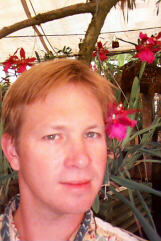 At
the Orchid Garden
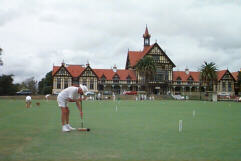
Hot time in Rotorua
|
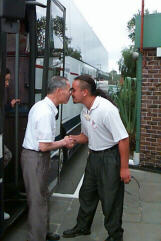 Greetings
Maori style
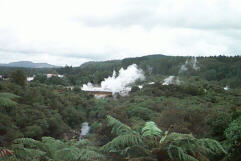
Steaming landscape of Whakarewarewa
|
18 February, Rotorua
(f) It felt good
to be back on the road and I am finally ready to admit
that my legs weren’t quite in the shape they were
when we started. Luckily we’d planned a tourism day
here in Rotorua. The night before we’d purchased
breakfast fixin’s and slurped our way through
breakfast in bed before venturing into daylight.
We wandered into town
after nine and arrived at our first tourist trap just in
time for the really big show. The orchid garden sported a
"Water Organ", sort of a dancing waters show.
It was kind of funny for about the first five minutes.
Lights changed colors, fountains swayed and spurted
rhythmically, all to the tune of our favorite classics
like Vivaldi’s Four Seasons and the William Tell
Overture – not! We were really disappointed as we
snuck out of the theater. Had we gotten there earlier we
could have made requests from their play list that
included such classics as Feelings and Jail House Rock.
The Orchid Garden itself was not even as interesting as
the Water Organ. Very few stunning specimens were to be
seen there.
Our next stop was to be
the Rotorua Museum. I was a little hesitant to pay the
entry fee when I noted that they had a Bob Marley
exposition in one of the galleries, but we paid the toll
and entered the frigid museum. There they detailed the
rich heritage of the Maoris, their skepticism for western
religion and the paradise-like environment they lived in
around Rotorua before the big events. One advent was the
appearance of European settlers and the second, perhaps
more dramatic, was the explosion of the mountain above
Rotorua. The flashes of the explosions were seen in
Auckland some 200 kilometers away and the sound heard in
Wellington three times that distance further. We read
account after account of the horror by survivors and saw
photos and other evidences of the victims. One was a
mummified cat that was on display in a plexiglass case
looking as though it was still uttering its last cry.
One surprise at the museum
is that they had the same lax standards of dress as the
rest of New Zealand. Seems almost one person in five
doesn’t even wear shoes. There were several museum
patrons wandering around the exhibit nearly naked. Their
attire seemed entirely appropriate in the exhibit
entitled "taking the cure". There the Rotoruans
chronicle the history of the healing power of the
sulfurous steamy waters that run from the ground
everywhere. The museum is housed in the old bathhouse for
the community and for the exhibit they restored a few of
the rooms and pools. Andy’s favorite part of the
exhibit was the photo of the famed electric bath. We both
pondered how fabulous and tingly that would feel, eesh!
The next exhibit primed us
for lunch. "About trout" was a simple
collection of fishing trophies, photos of the catch of
the day and flies. By the time we had walked through I
was ready for a fishy repast.
After lunch we’d
planned to go to the Maori Village and Geothermal park.
We started to wait for the shuttle bus, but took a taxi
instead. Our well-traveled driver had spent four weeks in
the States last summer. There she’d seen more of it
than I ever had, travelling in a van with seven other
Kiwis. She also gave us some insight into the problems
brewing at the tourist attraction we were about to visit.
We’d been tipped off that there was some issue there
by a seventy-year-old’s letter to the editor in the
paper the day before. He’d complained that he had to
pay two entry fees to see the sights he’d paid only
once to see before. The government had refused to
"cut" the Maori village in on the entry fees so
the villagers barricaded the entry and set up their own
tourist trap. Against our Maori driver’s
recommendation, we decided on the government-run
Geothermal Park and Cultural Center. There we knew
we’d be treated to geysers, steaming pools, boiling
mud puddles and a kiwi bird. Between the noise of the
park and the smell it was truly the only place on earth
you could be flatuant without anyone being the wiser.
All of this tourism in one
day, but don’t stop reading yet, because that
evening we also attended a Maori version of a luau. We
almost baled on it because the bus that was to pick us up
seemed to have forgotten us and when we called they had
lost our reservation. The desk clerk at our hotel
convinced us that it was worth seeing, so we ordered a
beer at the bar while waiting for our ride. Shirley the
bus driver came just as we had taken our first sip, she
made an immediate bad impression on me when she asked
that we pour them out before getting on her bus.
After we made a stop at
the office of the tour company to pay for our cultural
experience an older Maori dude boarded the bus and began
to brief us on the cultural protocol of the event to
come. He selected a leader for our group, a reluctant
dude named Ron. I listened intently waiting for the
explanation of how and why the Maoris greet one another
by rubbing noses. Vastly disillusioned when I learned
that only our leader would get to try out the nose
rubbing with the leaders of the host Maoris.
At our arrival we were
greeted by an angry Maori who strutted, cried and made
faces at us. His macho display was somehow diluted by the
fact that he was a raging queen. Once we negotiated a
truce with our hosts they invited us into their
meetinghouse where they sang, danced and educated us
before taking us to the holy mess tent. There we were
served the most vile meal that had been steamed in the
massive Maori outdoor oven, called a hangi.
Dinner’s cast of characters included a brooding
Israeli, a Brit and four trailer trash Americans. One
named Lucky could barely speak he seemed so drunk.
We finally made our way
home in the bus through the rain while Shirley led us in
a multi-national sing-along. Every imaginable bus song
was wailed by all. Lucky tmade us sing "Rocky
Mountain High," in tribute to the recently dead John
Denver. I longed to be finished with tourism and back on
my bike.
|
| 19 February, Rotorua
to Taupo, 103km (a) Dispelling any doubts that we were on the
tourist trail, European hitchhikers lined the road out of
town, holding signs marked "Taupo" and looking
rather pathetic in the drizzle. Yet again I found myself
happy having a bike to move me and my stuff around. The
morning’s riding was hardly ideal, though: busy SH5
led us up a gradual, interminable incline through
monotonous industrial forest.
At Waiotapu we turned onto
a side road passing through an area rich in geothermal
activity. We biked right up to what was the best bubbling
mud pool either of us has seen, marveling that this
attraction was available to us free of charge. Not so for
the "painted valley" down the road a piece,
where we rubbed shoulders once again with the ubiquitous
bus tourists. We gave the attraction a skip, but stopped
for a nasty lunch of meat pies.
When Fred got back on his
bike, he realized his rear derailleur cable was broken,
which basically transformed his 24-speed machine into a
3-speed Dutch cruiser suitable for a leisurely pedal
along the canals. Luckily, the terrain ahead was
relatively gentle. Our route plunged down into a vast
agricultural valley framed by volcanic ridges on either
side, with Mt. Tauhara (our goal of Taupo nestled at its
base) looming in the distance. I kept reassuring Fred
that we weren’t too far from the town, and that
we’d most likely be able to find a new cable for him
there. In the meantime, he strained in his pedals behind
my wind block. Just as we had resigned ourselves to a
plodding pace into Taupo against the wind, an apparition
emerged out of the drizzle: a panel van full of bicycle
parts stopped by the lonely roadside. Had breathing all
the sulfur fumes affected our brains?
It turned out to be a
group of Dutch cyclists on a package tour, eating a lunch
prepared for them by their amazingly equipped organizers.
In typical Dutch, no-nonsense style, a woman named Helene
sold Fred a new cable for something like four NZ dollars
--next to a sheep pasture, miles from the nearest town.
As Fred and Helene fixed
his bike, the Dutch cyclists bid us farewell one by one
until only one remained, a guy who told us to call him
Ray. Since he was on his own, we proposed that he ride
along with us to Taupo –a fatal error, it turns out.
Ray proved to be an able
rider, happy with our often sluggish pace (especially
uphill), yet oddly taciturn. He rode behind us most of
the way, never addressing a word to us. I kept forgetting
he was there as we cruised through pastureland punctuated
with forests of pine and steaming lakes of milky blue and
green. Nearing Taupo, we elected to take a detour to
check out a few tourist objects on our way into town: the
Aratiata Rapids, the Huka Falls, and yet another
geothermal area known evocatively as "Craters of the
Moon."
It was at the first of
these attractions that disaster struck. Atop the dam that
controls the rapids, I stopped, Ray stopped, and Fred
didn’t. At first I didn’t know what had
happened, beyond Fred and Ray hugging the road. Both of
them were pretty badly scraped up, especially Ray, who
appeared to be in somewhat of a state of shock. We
flagged down the first car to come along. The driver had
an American accent, and while he was headed in the other
direction, he offered to give Ray a lift into town, where
his compatriots had set up camp. For the rest of the day,
Fred and I kept looking at each other, feeling terrible
to have played a part in what is sure to be the low point
of Ray’s cycling holiday. By far the worst accident
we’ve been a part of this trip, the event sobered us
up a bit to the dangers of the road, and I hope
we’ll continue with an intensified sense of
caution…
As if to mock the darkness
of our mood, the sun had come out at this point, shining
on some of the most fetching scenery we’ve seen in
this country. Everything looked green and lush, and the
sound of the beautiful blue Waikato river filled the
ionized air. We gave the rest of the tourist stops a skip
in the interest of attending to Fred’s wounds, yet I
couldn’t help but being beguiled by our first view
of Lake Taupo –NZ’s largest—and the series
of volcanic peaks towering on its far shore.
Taupo is a charming little
place, full of tourists yet far less commercialized than
Rotorua. In the hot pool of our cheesy Canadian-run motel
I chatted with a trio of Kiwi tourists (two of them Dutch
immigrants living here for forty years) who clued me in
on certain aspects of NZ which have remained elusive to
me. According to the formerly Dutch gentleman from
Gisbourne, employers are hesitant to employ Maoris not
because they are racist but because it involves a
commitment to the employee’s entire family and
tribe. If someone in the family (close or extended) dies,
for example, the boss is expected to attend a funeral
that can last up to five days. I also quizzed them on
their opinions regarding the Prime Minister’s
proposed Code of Social Responsibility, which passes into
law such moral notions as "raising a child is the
responsibility of its family." All three dismissed
PM Jenny’s ideas as "nonsense."
At dinner we ran into our
mysterious American from this afternoon, the guy who
drove Ray into town. A fit-looking and self-possessed man
in his forties, he introduced himself as Robin and
offered to share with us the bottle of wine he’d
brought with him. He told us of his solo travels around
NZ by car and boat as well as his forays into the worlds
of wine and Steadycam operation. He left quite an
impression on both of us, a sort of traveling Buddha,
completely free of stress or negativity. In retrospect, I
should have asked him about my most pressing worry as we
prepare to turn in tonight: what can we do to improve our
karma that was so suddenly messed up on the dam today?
|
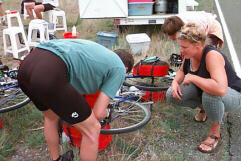 Fred's
better side while changing a derailleur cable
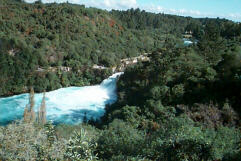
Huka Falls near Lake Taupo
|

